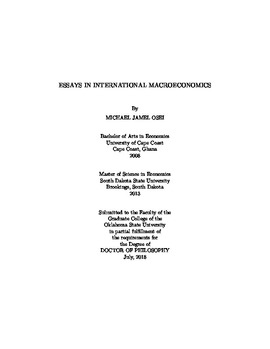| dc.contributor.advisor | Kim, Jaebeom | |
| dc.contributor.author | Osei, Michael Jamel | |
| dc.date.accessioned | 2019-03-20T19:25:36Z | |
| dc.date.available | 2019-03-20T19:25:36Z | |
| dc.date.issued | 2018-07 | |
| dc.identifier.uri | https://hdl.handle.net/11244/317639 | |
| dc.description.abstract | This dissertation consists of two essays in international macroeconomics. Recent studies have found that once a country achieves a certain minimum level of financial development threshold, foreign direct investment (FDI) has a positive effect on economic growth. In the first essay, using both linear and nonlinear specifications, I examine whether this positive effect differs in systematic ways depending on the level of financial development of a country. The empirical analysis is based on a panel of 62 middle and high income countries spanning the period 1987-2016. The findings from this paper suggest that at low levels of financial development, improving domestic financial market conditions have the effect of enabling host economies maximized the growth benefit of FDI. However, the growth effect of FDI tends to become negligible as a country becomes more financially developed, suggesting that more finance is not always better. | |
| dc.description.abstract | The second essay explores the FDI-finance-growth relationship within and across convergence clubs. For this purpose, I first use the log t regression test for convergence and clustering proposed by Phillips and Sul (2007) to examine whether countries converge to a single long run equilibrium. I find evidence of convergence clustering among two different clubs based on financial development and four different clubs based on real per capita GDP. In the second part, I examine whether the growth effect of FDI differs across convergence clubs using the two-step system generalized method of moments (GMM) estimator with Windmeijer's (2005) finite sample correction. In addition, I test for threshold effect in the FDI-finance-growth relationship for each club using a dynamic panel threshold technique. The empirical analysis is based on a panel of 62 middle and high income countries spanning the period 1987-2016. Overall, the growth effect of FDI displays substantial heterogeneity across convergence clubs, appearing to be smaller in clubs with higher average financial development. The results also point to the presence of threshold effects. The positive effect of FDI on economic growth kicks in only after a country achieves a minimum level of financial development threshold. But there is also a financial development threshold beyond which the growth effect of FDI becomes negligible. | |
| dc.format | application/pdf | |
| dc.language | en_US | |
| dc.rights | Copyright is held by the author who has granted the Oklahoma State University Library the non-exclusive right to share this material in its institutional repository. Contact Digital Library Services at lib-dls@okstate.edu or 405-744-9161 for the permission policy on the use, reproduction or distribution of this material. | |
| dc.title | Essays in international macroeconomics | |
| dc.contributor.committeeMember | Adkins, Lee | |
| dc.contributor.committeeMember | Shen, Wenyi | |
| dc.contributor.committeeMember | Krehbiel, Tim | |
| osu.filename | Osei_okstate_0664D_15822.pdf | |
| osu.accesstype | Open Access | |
| dc.type.genre | Dissertation | |
| dc.type.material | Text | |
| dc.subject.keywords | foreign direct investment | |
| dc.subject.keywords | financial development | |
| dc.subject.keywords | economic growth | |
| dc.subject.keywords | system GMM | |
| dc.subject.keywords | dynamic panel threshold | |
| dc.subject.keywords | club convergence | |
| thesis.degree.discipline | Economics | |
| thesis.degree.grantor | Oklahoma State University | |
